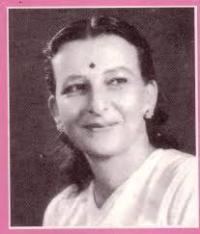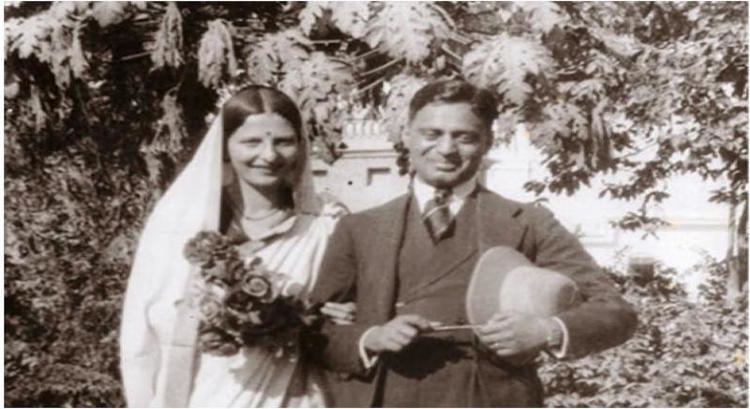Name Savitri Khanolkar Role Designer | Died 1990 | |
 | ||
Parents Marthe Hentzelt, Andre de Maday | ||
Savitri Bai Khanolkar (born Eve Yvonne Maday de Maros, 20 July 1913 – 26 November 1990) was a designer, best known for designing the Param Vir Chakra, India's highest military decoration, awarded for displaying distinguished acts of valour during wartime. Khanolkar also designed several other major gallantry medals including the Ashok Chakra (AC), Maha Vir Chakra (MVC), Kirti Chakra (KC), Vir Chakra (VrC) and Shaurya Chakra (SC). She had also designed the General Service Medal 1947, which was used until 1965.[2] Khanolkar was also a painter and an artist.
Contents
Born Eve Yvonne Maday de Maros in Neuchâtel, Switzerland, she married Indian Army Captain (later Major General) Vikram Ramji Khanolkar in 1932, and subsequently changed her name to Savitri Bai Khanolkar, became a Hindu and acquired Indian citizenship.

Soon after Indian independence, she was asked by the Adjutant General Major General Hira Lal Atal to design India’s highest award for bravery in combat, the Param Vir Chakra. Major General Atal had been given the responsibility of creating and naming independent India's new military decorations. His reasons for choosing Khanolkar were her deep and intimate knowledge of Indian mythology, Sanskrit and Vedas, which he hoped would give the design a truly Indian ethos.

Coincidentally, the first PVC was awarded to her elder daughter Kumudini Sharma's brother-in-law Major Som Nath Sharma from 4 Kumaon Regiment who was posthumously awarded on 3 November 1947 during the Indo-Pakistani War of 1947 in Kashmir.

Early life

Born in Neuchâtel, Switzerland to a Hungarian father André de Maday, professor of sociology at Geneva University and President of the Société de Sociologie de Genève, and Russian mother Marthe Hentzelt, who taught at the Institut Jean-Jacques Rousseau, she spent her early childhood in Geneva, where she grew to be a compassionate girl with a love of nature and the outdoors. In 1929, when she was still a teenager, she met Vikram Ramji Khanolkar. From a Marathi family, Khanolkar was a young Indian Army cadet undergoing training at the Royal Military Academy, Sandhurst in the United Kingdom, and was visiting Switzerland during a term break. Although he was many years older than she was, Eve fell in love with him. Her father however, did not agree to let her go away to a faraway country like India but Eve was a determined young woman, and her love was strong. She followed Vikram to India a few years later, and in 1932,she married him in Lucknow.She subsequently changed her name to Savitri Bai Khanolkar.
Indian connection
Despite coming (or maybe because of coming) from a European background, Savitri Bai identified so closely with Hindu traditions and ideals, that her integration into Indian society was smooth and effortless. She was a vegetarian, learnt to speak fluent Marathi, Sanskrit and Hindi and learnt Indian music, dance and painting. She always claimed that she had been "born in Europe by mistake" as she was Indian soul, and woe unto him who dared to call her a "foreigner"! She was so fascinated with Hindu mythology that she read extensively from Hindu scriptures and had a deep knowledge of India's ancient history and legends. It was this knowledge that led Major General Hira Lal Atal, the creator of the Param Vir Chakra, to ask for Savitri Bai's help in designing a medal that would truly symbolize the highest bravery.
The design of Param Vir Chakra
Savitribai thought of the sage Dadhichi – a vedic rishi who made the ultimate sacrifice to the Gods. He gave up his body so that the Gods could fashion a deadly weapon – a Vajra, or thunderbolt, from his spine. Savitribai gave Major General Hira Lal Atal, the design of the double Vajra, common in Tibet. It is a myth that the medal also carries images of the fearless warrior king Shivaji's sword Bhavani but this is a popular perpetuated myth. The Indian General Service Medal 1947 which did contain the Bhavani sword was withdrawn soon after.
The medal itself is a small one. It is cast in bronze with a radius of 13/8 inch (41.275 mm). In the centre, on a raised circle, is the state emblem, surrounded by four replicas of Indra's Vajra, flanked by the sword of Shivaji. The decoration is suspended from a straight swiveling suspension bar, and is held by a 32 mm purple ribbon.
Later life
Savitri Bai had always done a lot a social work which she continued in her later years, working with soldiers and their families and refugees who had been displaced during the Partition. After her husband's death in 1952, she found refuge in spirituality, and retired to the Ramakrishna Math. She wrote a book on the Saints of Maharashtra that is still popular today.
Death
Mrs. Savitri Bai Khanolkar died in 1990.
